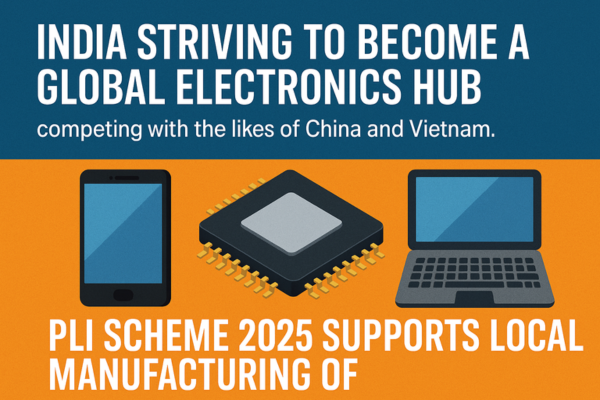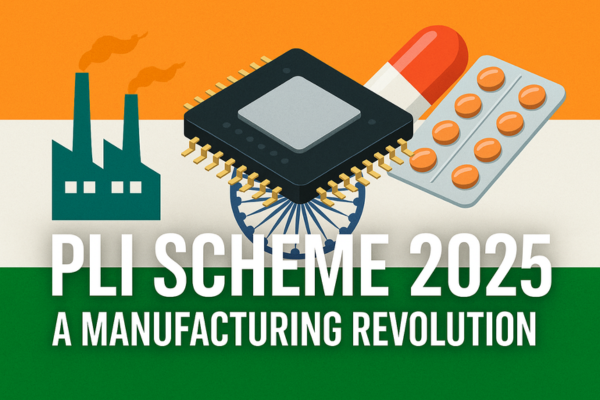Introduction: India’s Manufacturing Moment
India’s growth engine is accelerating—and one of its most powerful tools is the PLI Scheme 2025. The Production-Linked Incentive (PLI) scheme, introduced to encourage domestic manufacturing and reduce import dependence, is witnessing remarkable traction. In FY 2024–25 alone, nearly 70% of PLI disbursements were allocated to the electronics and pharmaceutical sectors, signaling a strong shift in India’s industrial roadmap.
In this blog, we explore the depth, direction, and future impact of the PLI Scheme 2025, and why it matters for India, businesses, and the global supply chain.
Table of Contents
What is the PLI Scheme 2025?
The PLI Scheme 2025 is a government initiative that offers financial incentives to companies based on incremental sales from products manufactured in India. The goal? To boost local production, attract foreign investments, generate employment, and strengthen India’s role in global manufacturing.
The scheme initially covered 13 sectors, including:
- Mobile phones and electronics
- Pharmaceuticals
- Automobiles and auto components
- Telecom
- Textiles
- White goods (ACs & LEDs)
- Solar PV modules
As of July 2025, the PLI Scheme has evolved further to support sunrise industries like green hydrogen, EV batteries, and semiconductors.
FY 2024–25: Electronics & Pharma Take the Lead
In the most recent fiscal year, 70% of total PLI disbursements were absorbed by the electronics and pharma industries. This shift demonstrates the government’s focus on two strategic pillars:
📱 Electronics:
India is striving to become a global electronics hub, competing with the likes of China and Vietnam. The PLI Scheme 2025 supports local manufacturing of:
- Smartphones
- Semiconductors
- LED panels
- Electronic components
Major beneficiaries include global giants like Apple (via Foxconn), Samsung, and Indian players such as Dixon Technologies and Vedanta-Foxconn JV.
💊 Pharmaceuticals:
India is the “pharmacy of the world.” The PLI Scheme 2025 supports production of Active Pharmaceutical Ingredients (APIs), critical drugs, and medical devices. This reduces dependence on imports from countries like China and boosts India’s self-reliance.
Companies like Lupin, Cipla, and Sun Pharma are among the beneficiaries.
PLI Scheme 2025: Key Feature
- Performance-based incentives ranging from 4% to 10%
- Targets both domestic and foreign manufacturers
- Multi-year implementation window (usually 5–7 years)
- Designed to foster long-term investments
- Monitored by nodal ministries (e.g., MeitY, DoP, DPIIT)
Positive Impact of the PLI Scheme 2025
✅ Employment Generation
The PLI Scheme 2025 has already created lakhs of jobs, directly and indirectly. As industries ramp up production, demand for skilled labor rises across engineering, manufacturing, quality assurance, and R&D.
✅ Export Growth
India’s electronics exports reached a record $23 billion in FY25, and pharma exports touched $28 billion—largely propelled by PLI Scheme 2025.
✅ Import Reduction
By incentivizing local production, India reduces dependence on countries like China, especially for critical components like APIs and semiconductors.
✅ MSME Empowerment
Many MSMEs act as ancillary units to large PLI-approved companies. This generates ripple effects across local economies and helps small businesses grow sustainably.
Criticisms and Challenges
Despite its achievements, the PLI Scheme 2025 is not without challenges:
- Delayed disbursements due to compliance checks
- Limited participation from small players due to high entry thresholds
- Some schemes (like telecom and solar) are witnessing lower-than-expected uptake
Experts suggest recalibrating incentive timelines and providing better support for MSMEs to widen the impact.

Global Comparison: India vs China & Vietnam
India is positioning itself as a viable alternative to China in global supply chains. The PLI Scheme 2025 is India’s version of China’s large-scale industrial subsidy programs and Vietnam’s tax-friendly FDI policies.
Key differentiators:
| Country | Policy | Focus |
|---|---|---|
| India | PLI Scheme 2025 | Incentives based on incremental sales |
| China | State subsidies | State-directed manufacturing |
| Vietnam | FDI incentives | Tax exemptions for foreign firms |
India’s PLI model is performance-driven, offering measurable outcomes and scalable benefits.
Government’s Vision for the Future
The PLI Scheme 2025 is a stepping stone toward:
- $1 trillion manufacturing economy by 2030
- Becoming a global semiconductor hub
- Driving the Green India mission with local EV battery and solar panel manufacturing
- Boosting AI, robotics, and advanced tech industries
In the coming budget cycles, the government is expected to extend PLI schemes to newer sectors like:
- AI chips & processors
- Clean hydrogen
- Space tech
- Precision agriculture
Quotes from Policy Experts
“The PLI Scheme 2025 is not just about incentives; it’s about reshaping India’s industrial DNA.” – Dr. Arvind Panagariya, Economist
“India’s success in electronics and pharma will lay the groundwork for the next phase of industrial expansion.” – NITI Aayog Official
How PLI Scheme 2025 Affects You
If you’re a:
- Business Owner – Explore opportunities to become a supplier or ancillary unit
- Job Seeker – Upskill in electronics, pharma, or EV tech
- Student – Follow current affairs and government schemes for exams like UPSC, SSC, and banking
- Blogger or Analyst – Track updates and budget allocations for trending content
✅ What is the PLI Scheme 2025?
The Production Linked Incentive (PLI) Scheme 2025 is an updated government initiative aimed at boosting domestic manufacturing in India. It provides financial incentives to companies that increase their production in key sectors like electronics, automobiles, pharmaceuticals, textiles, and more.
But here’s the big question:
💡 How Does the PLI Scheme 2025 Affect YOU?
Let’s break it down into 7 real-life impacts that make this scheme more than just a policy—it’s a people-centric economic strategy.
1️⃣ More Job Opportunities — Especially for Youth
How it affects you:
With companies expanding manufacturing units under the PLI Scheme 2025, the demand for labor and skilled professionals increases. This leads to:
- New jobs in sectors like electronics, EVs, textiles, and telecom
- More internships and skilling programs for freshers
- Better wages due to competitive hiring
Impact: Expect millions of new jobs by 2026, especially in Tier 2 and Tier 3 cities.
2️⃣ Boost to “Make in India” — Products Get Cheaper
How it affects you:
As Indian-made products replace imports, the cost of goods in the local market goes down. For example:
- Smartphones, TVs, EVs, and solar panels could become 10–15% cheaper
- Availability increases due to local supply chains
Impact: You pay less for quality products made in India.
3️⃣ Startups and MSMEs Get a Push
How it affects you:
The PLI Scheme 2025 encourages MSMEs and startups to be part of the larger supply chain by offering:
- Vendor development programs
- Access to capital and global buyers
- Inclusion in government procurement
Impact: If you’re a startup founder or a small business owner, you now have greater access to funding, manufacturing contracts, and government support.
4️⃣ Technology Upgrades and Innovation
How it affects you:
Global giants and Indian firms are encouraged to invest in R&D, adopt cutting-edge technology, and develop local IP.Examples:
- 5G telecom equipment made in India
- Locally assembled electric vehicles (EVs) with better mileage
- Green energy solutions like lithium-ion batteries and solar cells
Impact: Consumers like you enjoy smarter, faster, and more eco-friendly products.
5️⃣ Regional Growth: Your City Could Be Next
How it affects you:
Many PLI-backed manufacturing hubs are being set up in smaller cities like Indore, Surat, Aurangabad, and Ranchi.Impact on daily life:
- Better roads, schools, hospitals due to industrial investment
- Housing demand and real estate value increases
- Local businesses (cafes, gyms, transport) benefit from rising incomes
6️⃣ Enhanced Exports = Stronger Rupee
How it affects you:
As India exports more, it earns more foreign exchange, helping to strengthen the Indian Rupee.Impact:
- Foreign travel becomes cheaper
- Fuel prices stay under control
- Reduced inflation benefits everyone, especially the middle class
7️⃣ Environmentally Friendly Manufacturing
How it affects you:
PLI Scheme 2025 prioritizes green manufacturing and sustainability in sectors like renewable energy and EVs.Results:
- Cleaner air with EV adoption
- Energy-efficient appliances become standard
- Lower pollution in industrial zones
Impact: You and your family breathe cleaner air and live in healthier cities.
📊 Sectors Included in PLI Scheme 2025
Sector Impact on You Electronics (mobiles, semiconductors) Cheaper gadgets, new tech jobs EVs & Auto Components Affordable electric cars, greener roads Pharmaceuticals Cheaper medicines, better healthcare access Textiles Boost for fashion industry, export jobs Telecom 5G-ready India, better networks Solar Equipment Cheaper energy bills, cleaner environment Food Processing Better quality packaged food 🧠 Did You Know?
The PLI Scheme 2025 is expected to contribute $520 billion in additional production over the next five years and create 6 million+ jobs across India.
📌 Final Thoughts: Why Should You Care?
The PLI Scheme 2025 is more than just a government plan. It’s a national movement to make India self-reliant (Atmanirbhar Bharat) while improving your quality of life.
Whether you’re a student, a small business owner, a job seeker, or a daily consumer, the scheme touches you directly or indirectly through:
- Better job access
- Affordable products
- Healthier environments
- Improved infrastructure
Conclusion: A Defining Leap for Make in India
The PLI Scheme 2025 is more than just a policy—it’s a national mission to reimagine India’s economic structure. With electronics and pharma sectors leading the charge, India is asserting itself as a self-reliant, export-driven, and high-tech economy.
Stay tuned to Current Pulse Jay as we continue to track how the PLI Scheme 2025 shapes India’s future in manufacturing and global trade.

